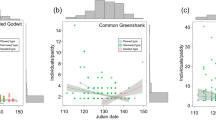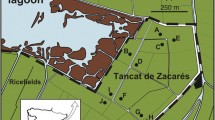Abstract
The 2011 Tohoku Earthquake Tsunami hit the Pacific coast of eastern Japan on March 11, 2011 and disturbed various ecosystems, including rice paddies along the coast. In Miyagi Prefecture, located in the Tohoku Region, a total of 12685 ha, or about 11.5 % of the rice paddies, were inundated and damaged by the tsunami. Although rice paddies are artificially constructed, they have long been used by many kinds of aquatic animals as habitats. To assess impacts of the 2011 Tohoku Earthquake Tsunami on aquatic animals inhabiting the rice paddies, census surveys were conducted at inundated and non-inundated rice paddies at six sites along the coast of Miyagi Prefecture from June to July 2012. This was 30–60 days after the first transplanting of rice seedling in inundated rice paddies following the tsunami. In the surveys a total of 100 aquatic animal taxa, 72 from inundated and 86 from non-inundated rice paddies, were found. Although the taxonomic richness and composition differed among the sites, the total number of observations of walk dispersers and obligatory aquatic animals without resting stages were significantly lower in inundated than in non-inundated rice paddies. However, no notable difference was detected in taxonomic richness and the total number of observations of flight dispersers and obligatory aquatic animals with resting stages between inundated and non-inundated rice paddies. The results showed that the tsunami had a substantial impact on freshwater animals but that restoration of the paddies for rice cultivation enhanced rapid recolonization by aquatic animals with high dispersal abilities and resting stages.





Similar content being viewed by others
References
Bourrouilh-Le Jan FG, Beck C, Gorsline DS (2007) Catastrophic events (hurricanes, tsunami and others) and their sedimentary records: introductory notes and new concepts for shallow water deposits. Sediment Geol 199:1–11
Dodd CK (2010) Amphibian ecology and conservation-a handbook of techniques. Oxford University Press, New York, p 112
Dodson SL, Caceres CE, Rogers DC (2010) Cladocera and Other Branchiopoda. In: Thorp JH, Covich AP (eds) Ecology and Classification of North American Freshwater Invertebrates. Academic Press, London, pp 773–827
Dugan PJ (1993) Wetlands in danger: a World Conservation Atlas. Oxford University Press, New York, p 187
Dunlop JE, Horrigan N, McGregor G, Kefford BJ, Choy S, Prasad R (2008) Effect of spatial variation on salinity tolerance of macroinvertebrates in Eastern Australia and implications for ecosystem protection trigger values. Environ Pollut 151:621–630
Fasola M, Canova L, Saino N (1996) Rice fields support a large portion of herons breeding in the Mediterranean region. Colon Waterbirds 19:129–134
Fujioka M, Lane SL (1997) The impact of changing irrigation practices in rice fields on frog populations of the Kanto Plain, central Japan. Ecol Res 12:101–108
Fujioka Y, Tabuchi R, Hirai Y, Yoneda R, Patanaponpaiboon P, Poungparn S, Shibuno T, Ohba H (2008) Disturbance and recovery of mangrove forests and macrobenthic communities in Andaman Sea, Thailand following the Indian Ocean Tsunami. In: Proceedings of the 11th International Coral Reef Symposium, Ft. Lauderdale, Florida, 7–11 July 2008, vol 2, pp 831–835
Gibbs JP (1999) Wetland loss and biodiversity conservation. Conserv Biol 14:314–317
Goslee SC, Urban DL (2007) The ecodist package for dissimilarity-based analysis of ecological data. J Stat Softw 22(7):1–19
Graham TB, Wirth D (2008) Dispersal of large branchiopod cysts: potential movement by wind from pothole on the Colorado Plateau. Hydrobiol 600:17–27
Green AJ, Jenkins KM, Bell D, Morris PJ, Kingsford RT (2008) The potential role of waterbirds in dispersing invertebrates and plants in arid Australia. Freshw Biol 53:380–392
Haraguchi T, Iwamatsu A (2012) Detailed maps of the impacts of the 2011 Japan Tsunami: Aomori, Iwate and Miyagi Prefectures, vol 1. Kokon-Shoin Publishers Ltd, Tokyo, p 167
Hayasaka D, Goka K, Thawatchai W, Fujiwara K (2012a) Ecological impacts of the 2004 Indian Ocean tsunami on coastal sand-dune species on Phuket Island, Thailand. Biodivers Conserv 21:1971–1985
Hayasaka D, Shimada N, Konno H, Sudayama H, Kawanishi M, Uchida T, Goka K (2012b) Florsitic variation of beech vegetation caused by the 2011 Tohoku-oki tsunami in northern Tohoku, Japan. Ecol Eng 44:227–232
Heckman CW (2005) The evolution from marsh to rice field. In: Fernando CH, Goltenboth F, Margaraf J (eds) Aquatic ecology of rice fields: a global perspective. Volumes Publishing, Ontario, pp 1–71
Jaramillo E, Dugan JE, Hubbard DM, Melnick D, Manzano M, Duarte C, Campos C, Sanchez R (2012) Ecological implications of extreme events: footprints of the 2010 earthquake along the Chilean Coast. PLoS ONE 7:1–8
Jinguji H, Tuyuzaki H, Ueda T (2010) Effects of temperature and light on the hatching of overwintering eggs in three Japanese Sympetrum species. Paddy Water Environ 8:385–391
Johnson CG (1969) Migration and Dispersal of insects by flight. Methuen & Co. Ltd, London, p 763
Kanaya G, Suzuki T, Maki H, Nakamura Y, Miyajima Y, Kikuchi E (2012) Effects of the 2011 tsunami on topography, vegetation, and macrobenthic fauna in Gamo Lagoon, Japan (in Japanese). Jpn J Benthol 67:20–32
Kawai T, Tanida K (eds) (2005) Aquatic insects of Japan: manual with keys and illustrations. Tokai University Press, Tokyo, p 1342
Keddy PA (2000) Wetland ecology-principles and conservation. Cambridge University Press, USA, p 614
Kefford BJ, Papas PJ, Nugegoda D (2003) Relative salinity tolerance of freshwater macroinvertebrates from the south-east Cape, South Africa compared with the Barwon Catchment, Victoria, Australia. Mar Freshw Res 54:755–765
Kiritani K (2000) Integrated biodiversity management in paddy fields: shift of paradigm from IPM to IBM. Int Pest Manag Rev 5:175–183
Krishnankutty N (2006) Effects of 2004 tsunami on marine ecosystems—a perspective from the concept of disturbance. Curr Biol 90:772–773
Lawler SP (2001) Rice fields as temporary wetlands: a review. Isr J Zool 47:512–528
Legendre P, Legendre L (2012) Numerical Ecology. Elsevier, Amsterdam, pp 310–311
Li H, Zhou W, Gao H, Zhang L (2006) Joint toxicity of salinity and alkalinity to oriental weatherfish Misgurnus anguillicaudatus by uniform design (in Chinese). Shuichan Kexue 25:563–566
Lupi D, Rocco A, Rossaro B (2013) Benthic macroinvertebrates in Italian rice fields. J Limnol 72:184–200
Maltby E, Barker T (2009) The wetlands handbook. Blackwell Publishing Ltd., Oxford, pp 1–42
Marques AM, Vicente L (1999) Seasonal variation of waterbird prey abundance in the Sado Estuary rice fields. Ardeola 46:231–234
Matsuhashi T, Okuyama H (2007) Frogs and toads of Japan + Salamander. YAMA-KEI Publishers Co., Ltd. Tokyo, Japan, p 191
Matsui M, Seki S (2010) The Handbook of Tadpoles. Bun-ichi Sogo Shuppan Co., Ltd., Tokyo, p 79
Ministry of Agriculture, Forestry and Fisheries in Japan (2011) The Great East Japan Earthquake (http://www.maff.go.jp/e/quake/press_110312-1.html)
Ministry of Agriculture, Forestry and Fisheries in Japan (2012) (http://www.maff.go.jp/j/press/nousin/bousai/120420.html)
Mukai Y, Ishii M (2007) Habitat utilization by the giant water bug, Appasus (=Diplonychus) major (Hemiptera: Belostomatidae), in a traditional rice paddy water system in northern Osaka, central Japan. Appl Entomol Zool 42:595–605
Naito R, Yamazaki M, Imanishi A, Natuhara Y, Morimoto Y (2012) Effects of water management, connectivity, and surrounding land use on habitat use by frogs in rice paddies in Japan. Zool Sci 29:577–584
Oksanen J, Guillaume F, Kindt BR, Legendre P, Minchin PR, O’Hara RB, Simpson GL, Solymos P, Henry M, Stevens H, Wagner H (2011) Vegan: Community Ecology Package. R package version 2.0-2. http://CRAN.R-project.org/package=vegan
R Core Team (2012) R: a language and environment for statistical computing. R Foundation for Statistical Computing, Vienna, Austria. ISBN 3-900051-07-0. http://www.R-project.org/
Rad HE, Aref F, Rezaei M (2012) Response of rice to different salinity levels during different growth stages. Res J Appl Sci Eng Technol 4:3040–3047
Rizo-Patron F, Kumar A, Colton MBM, Springer M, Trama FA (2013) Macroinvertebrate communities as bioindicators of water quality in conventional organic irrigated rice fields in Guanacaste, Costa Rica. Ecol Indic 29:68–78
Saijo H (2001) Seasonal prevalence and migration of aquatic insects in paddies and an irrigation pond in Shimane Prefecture (in Japanese). Jpn J Ecol 51:1–11
Saijo H (2002) The role of loach-farming paddy on the life cycle of aquatic insects inhabiting lentic habitats (in Japanese). Jpn J Ecol 52:155–165
Schwentner M, Timms BV, Richter S (2012) Flying with the birds? Recent large-area dispersal of four Australian Limnadopsis species (Crustacea: Branchiopoda: Spinicaudata). Ecol Evol 2:1605–1626
Seike K, Shirai K, Kogure Y (2013) Disturbance of shallow marine soft-bottom environments and megabenthos assemblages by a huge tsunami induced by the 2011 M9.0 Tohoku-Oki earthquake. PLoS ONE 8(6):e65417
Sites RW, Vitheepradit A (2010) Recovery of the freshwater lentic insect fauna in Thailand following the tsunami of 2004. Raffles Bull Zool 58:329–348
Sparling DW (2010) Water-quality criteria for amphibians. In: Dodd CK (ed) Amphibian ecology and conservation—a handbook of techniques. Oxford University Press, New York, pp 105–120
Suzuki T, Sasaki M (2010) Civil procedure for researching benthic invertebrate animals inhabiting tidal flats in eastern Japan. Plankton Benthos Res 5:221–230
Thorp JH, Covich AP (eds) (2010) Ecology and classification of North American freshwater invertebrates. Academic Press, London, p 1021
Ueno M (eds) (1980) Freshwater biology of Japan. Enlarged and revised edition. Hokuryukan Publishing Co., Ltd., Tokyo, p 760
Urabe J, Suzuki T, Nishita T, Makino W (2013) Immediate ecological impacts of the 2011 Tohoku Earthquake Tsunami on intertidal flat communities. PLoS ONE 8:1–6
Van der Valk AG (2012) The biology of freshwater wetlands, 2nd edn. Oxford University Press, New York, p 280
Vandekerkhove J, Martens K, Rossetti G, Mesquita-Joanes F, Namiotko T (2013) Extreme tolerance to environmental stress of sexual and parthenogenetic resting eggs of Eucypris vires (Crustacea, Ostracoda). Freshw Biol 58:237–247
Whanpetch N, Nakaoka M, Mukai H, Suzuki T, Nojima S, Kawai T, Aryuthaka C (2010) Temporal changes in benthic communities of seagrass beds impacted by a tsunami in the Andaman Sea, Thailand. Estuar, Coast Shelf Sci 87:246–252
Wiggins GB, Mackay RJ, Smith IM (1980) Evolutionary and ecological strategies of animals in annual temporary pools. Archiv fur Hydrobiol Suppl 58:97–206
Williams DD (2006) The biology of temporary waters. Oxford University Press, New York, p 337
Acknowledgments
This study was financially supported by Mitsui & Co., Ltd. Environment Fund (F11-F1-020), Earthwatch Japan, and a Grant-in-Aid for Scientific Research B (No. 25291094) from the MEXT Japan to JU. We thank Shigeo Yasuda, Yukiho Ito, and participants of the citizen research program by Earthwatch Japan. We are grateful to the farmers who allowed us to investigate their paddies.
Author information
Authors and Affiliations
Corresponding author
Additional information
Handling Editor: Nisikawa Usio
Appendix
Appendix
Ordination of study sites using principal component analysis (PCA) of land use and land cover within a 2000-m radius of the sites. Land cover and land use data were obtained from GIS dataset provided by the Ministry of the Environment of Japan and arcsine square root transformed before PCA analysis. Subscript “i” and “n” denote inundated and non-inundated paddies, respectively
Rights and permissions
About this article
Cite this article
Mukai, Y., Suzuki, T., Makino, W. et al. Ecological impacts of the 2011 Tohoku Earthquake Tsunami on aquatic animals in rice paddies. Limnology 15, 201–211 (2014). https://doi.org/10.1007/s10201-014-0432-5
Received:
Accepted:
Published:
Issue Date:
DOI: https://doi.org/10.1007/s10201-014-0432-5





